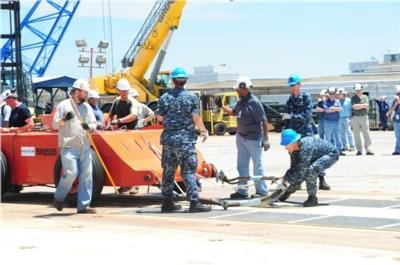Test Sled Launched From The Starboard Bow Catapult
With the successful launch of the first test sled from the starboard bow catapult, Naval Air Systems Command (NAVAIR) continued to make history June 16 with the Electromagnetic Aircraft Launch System (EMALS) aboard the future USS Gerald R. Ford (CVN 78).

Hurling the dead-load sleds, which represent different aircraft weights, marks a significant testing milestone for the first new aircraft launch technology employed by the Navy in more than 60 years.
In a ceremonial gesture, Susan Ford Bales, the ship's sponsor and daughter of the late President Ford for whom the ship is named, gave the launch signal by extending her left arm while on one knee. "The adrenaline of seeing the speed of the launch was amazing," Bales said.
Dead-load testing is a joint effort among NAVAIR, the Naval Sea Systems Command, the crew of CVN 78, EMALS prime contractor General Atomics, and Huntington Ingalls Industries Newport News Shipbuilding, the shipbuilder. The ship's test data will be compared to land-based test data, and after adjustments, becomes the basis for test launching the first manned aircraft off the ship in 2016.
Before the launch, Bales and other dignitaries signed the dead-load, which was first used June 5, and nicknamed "Ledder Rip," after John D. Ledder, the Newport News lead for NAVAIR’s Carrier and Field Service Unit (CAFSU) and had significant role in supporting the EMALS installation on CVN 78. Ledder died in 2012.
"It is truly fitting we recognized John today," said Capt. Douglas Belvin, deputy program manager for future systems in the Aircraft Launch and Recovery Equipment Program Office (PMA-251). "Behind this event are thousands of talented civilian engineers and technicians who dedicate their life's work to delivering new technologies to the fleet."
An example of NAVAIR’s civilian talent, CAFSU is the link between the aviation program offices and the hands-on work of building, maintaining, and overhauling the Navy’s aviation-capable ships.
“CAFSU plays a very important role for NAVAIR,” said Robert Puakea, the current CAFSU lead at the Supervisor of Shipbuilding Newport News office. “Not only do we ensure NAVAIR's equipment gets installed and tested correctly, we interface daily with the shipbuilder to make real-time decisions as needed and reach back to the teams at Lakehurst [and Patuxent River], so they know how to adjust designs or procedures to make future aircraft launch and recovery equipment systems work better.”
Puakea said EMALS testing is still maturing. "We are very early in collecting the test data,” Puakea said. “We have to remember that in terms of EMALS, everything we are doing is brand new. This is the only place on the planet where electromagnetics are going to launch tactical aircraft off a carrier."
Electromagnetics offer several advantages over steam-powered catapults.
The newer system has a wider energy range over the current steam-powered catapults. A wider energy range expands the Navy's future aircraft carrier operational capabilities, supporting the launch of the current and planned air wing composition — from lightweight unmanned aerial systems to heavy strike fighters.
EMALS also provides increased sortie rates, more accurate end speed control and smoother acceleration, which reduces stresses on aircraft during launch.
The system automates much of the maintenance and troubleshooting procedures and employs a modular architecture, allowing for easier repairs or component replacements. This then permits a reduction in the human workload required to operate and maintain the system, and a subsequent cost reduction over time.
Removal of a significant amount of steam, hydraulic, and air piping also means Sailors will enjoy cooler and quieter working and living spaces.
(U.S. Navy Image)
 Unfortunate... ANN/SportPlane Resource Guide Adds To Cautionary Advisories
Unfortunate... ANN/SportPlane Resource Guide Adds To Cautionary Advisories ANN FAQ: Turn On Post Notifications
ANN FAQ: Turn On Post Notifications ANN's Daily Aero-Term (04.29.24): Visual Approach Slope Indicator (VASI)
ANN's Daily Aero-Term (04.29.24): Visual Approach Slope Indicator (VASI) ANN's Daily Aero-Term (04.28.24): Airport Marking Aids
ANN's Daily Aero-Term (04.28.24): Airport Marking Aids ANN's Daily Aero-Linx (04.28.24)
ANN's Daily Aero-Linx (04.28.24)



